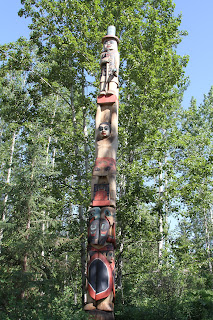 Today was another beautiful, hot day here in Anchorage. We
used our Tour Saver Book and went to the Alaska Native Heritage Center.
“Alaska’s Native people are divided into eleven distinct cultures, speaking
twenty-one different languages”. There are six different examples of the type
houses the natives lived in. The guide, Sarah, told us that the only time the
natives would live in an igloo, might be when they were hunting, and needed
shelter overnight. She also told us that the name Eskimo was a French Canadian
term that meant raw meat eaters. The natives ate a lot of their meat raw,
because they weren't able to have fires some of the time. She also made a joke
that said if you like sushi, you are an Eskimo.
Today was another beautiful, hot day here in Anchorage. We
used our Tour Saver Book and went to the Alaska Native Heritage Center.
“Alaska’s Native people are divided into eleven distinct cultures, speaking
twenty-one different languages”. There are six different examples of the type
houses the natives lived in. The guide, Sarah, told us that the only time the
natives would live in an igloo, might be when they were hunting, and needed
shelter overnight. She also told us that the name Eskimo was a French Canadian
term that meant raw meat eaters. The natives ate a lot of their meat raw,
because they weren't able to have fires some of the time. She also made a joke
that said if you like sushi, you are an Eskimo.
Most of the homes were covered with dirt and sod, with a
skylight that could be covered with sown intestine, to keep out the cold and
let light in. One of them had tunnels that were u shaped to keep out cold, and
allow the inhabitants to leave in the winter when the regular entry was buried
in snow.
This is Sarah, our tour guide. She told us she is 16 years old, and has been working at the Center for two years.The long black thing by her is whale baleen. The natives would roll it up, because when moist, it is very flexible. They would then cover it with something the Polar Bears would eat. After it got into the stomach, the acid would dissolve the string that held it rolled up, letting the baleen straighten out, killing the bear. On the picture above notice the boards on the floor. They cover the tunnels for exit in the winter.
One of the homes was made with large logs to hold the roof
up with a log ladder going to the hole in the roof for exiting the home. Sarah
also told us that the weather was so cold most of the time, that the people
only had three months to prepare for nine months of winter. It was also so cold
that there wasn't as much fighting among the different tribes as there was in
the lower 48 states. The notched log by Sarah is the ladder to go out the top of the home.
This type house was built where the trees were plentiful, and some were very large.
 |
| Cindy by the totem pole. |
 |
| This home had small totem poles on the support columns. |
After the tour, we went inside, where there was a dance
demonstration put on about the different cultures’ dancing and singing. We
thought the Native Heritage Center was worth seeing, and recommend it.
 |
| This whale skeleton was very large. |
 |
| One of the canoes covered with Seal skin. |
 |
| This canoe was covered with intestine. |
There is one display that has a Mammoth Tusk. It explains
why they think the mammoths went extinct. There is also a section that has a
collection of old and rare books that if you want, they will give you gloves
and you can examine the books. There was a display with a gold piece that was
about 46 troy ounces that someone found in discarded gravel. At today’s prices,
it would be worth about $70,000.
 |
| Some of the books are very old. |
 |
| This carved horn was interesting. |
 |
| The quilt Cindy has been working on. |
After all of this, we came back to the 5er and Cindy
finished up her quilt as far as she could go. There are some more boarders to
go on, but will have to wait until we get home, because we ran out of the
boarder material.
Tomorrow we will be heading further south. We are not sure
how far we will go, but we have been told that the scenery gets better the
further toward Homer you go.
Thanks for visiting.



















No comments:
Post a Comment